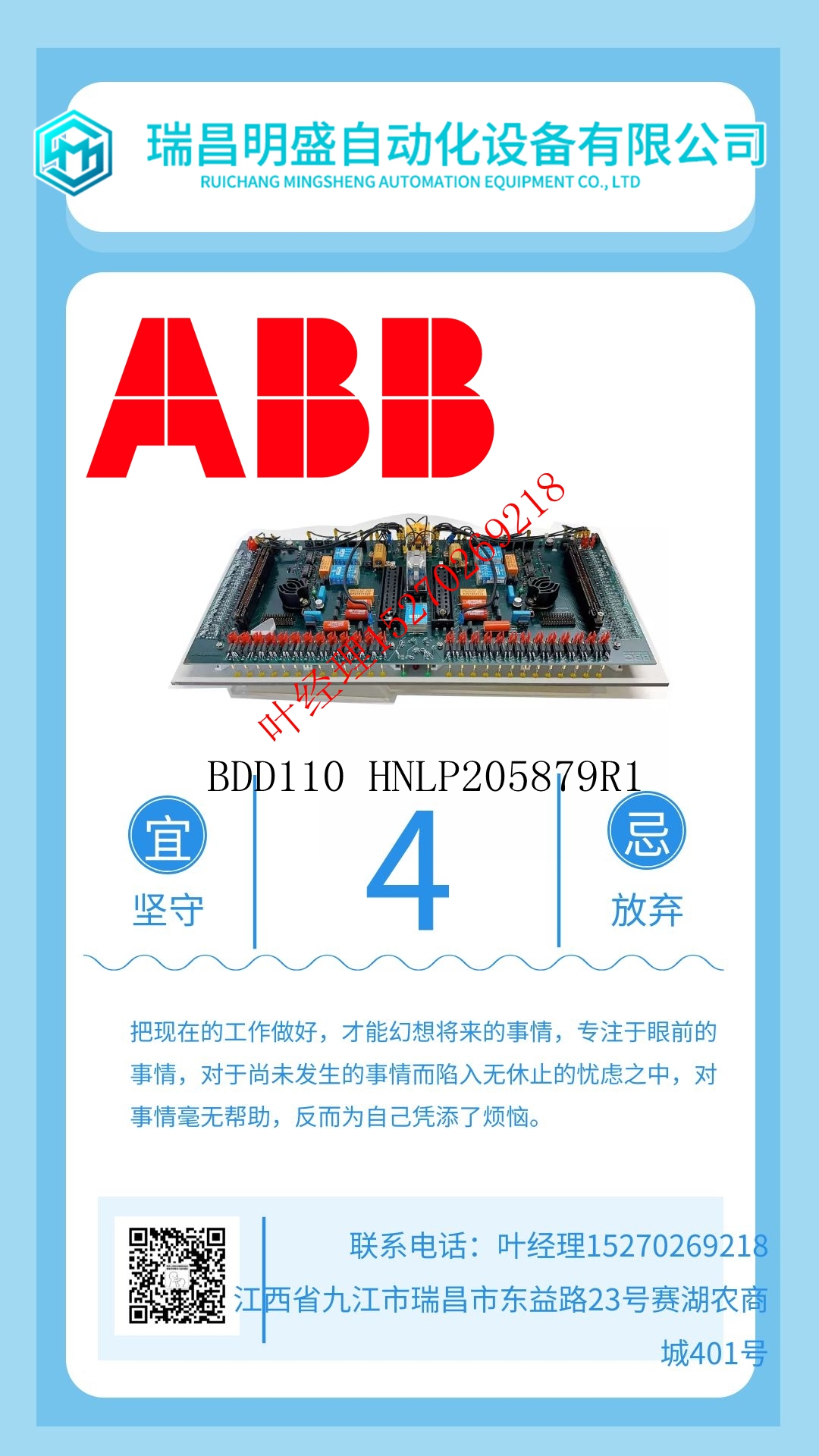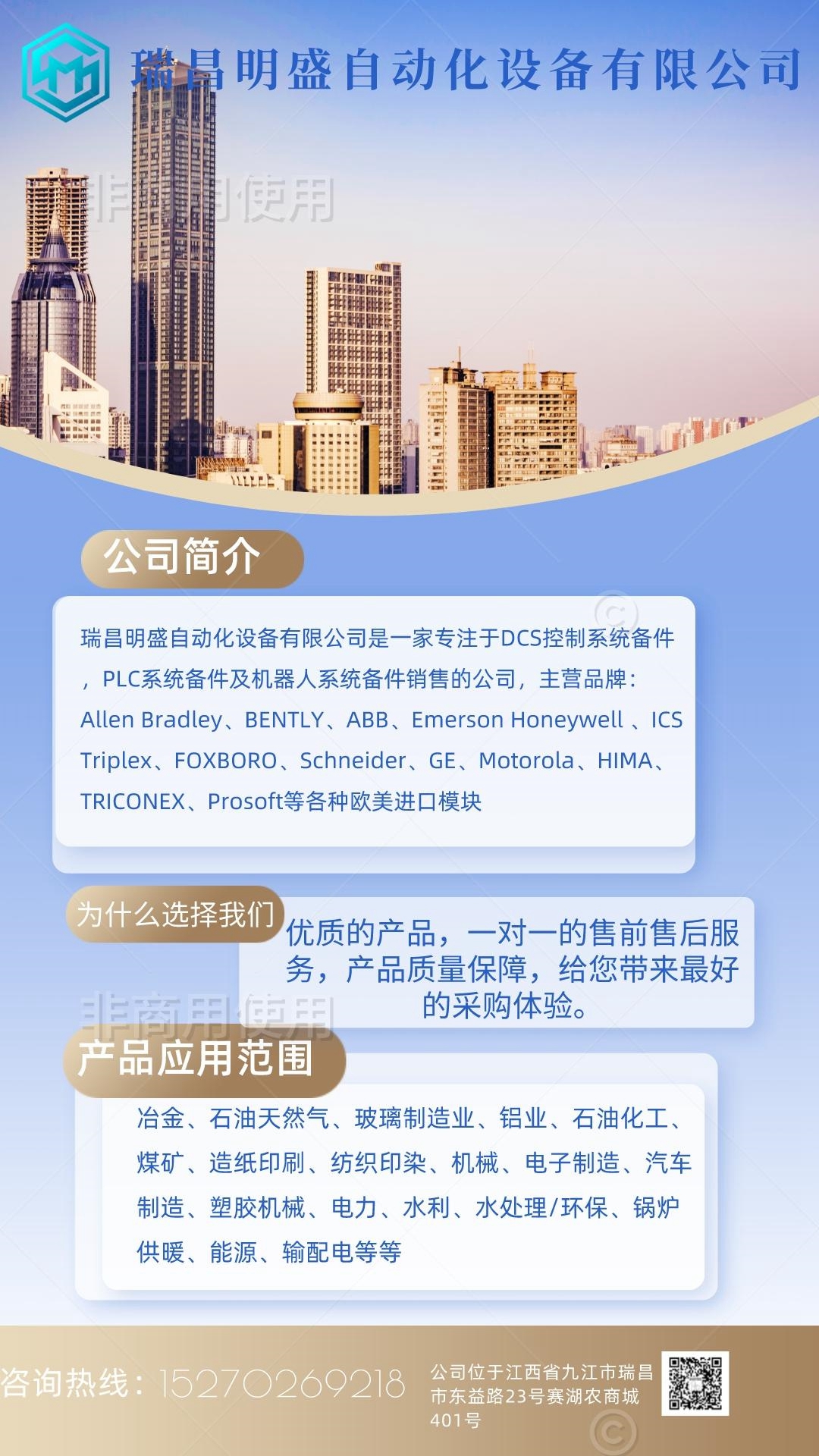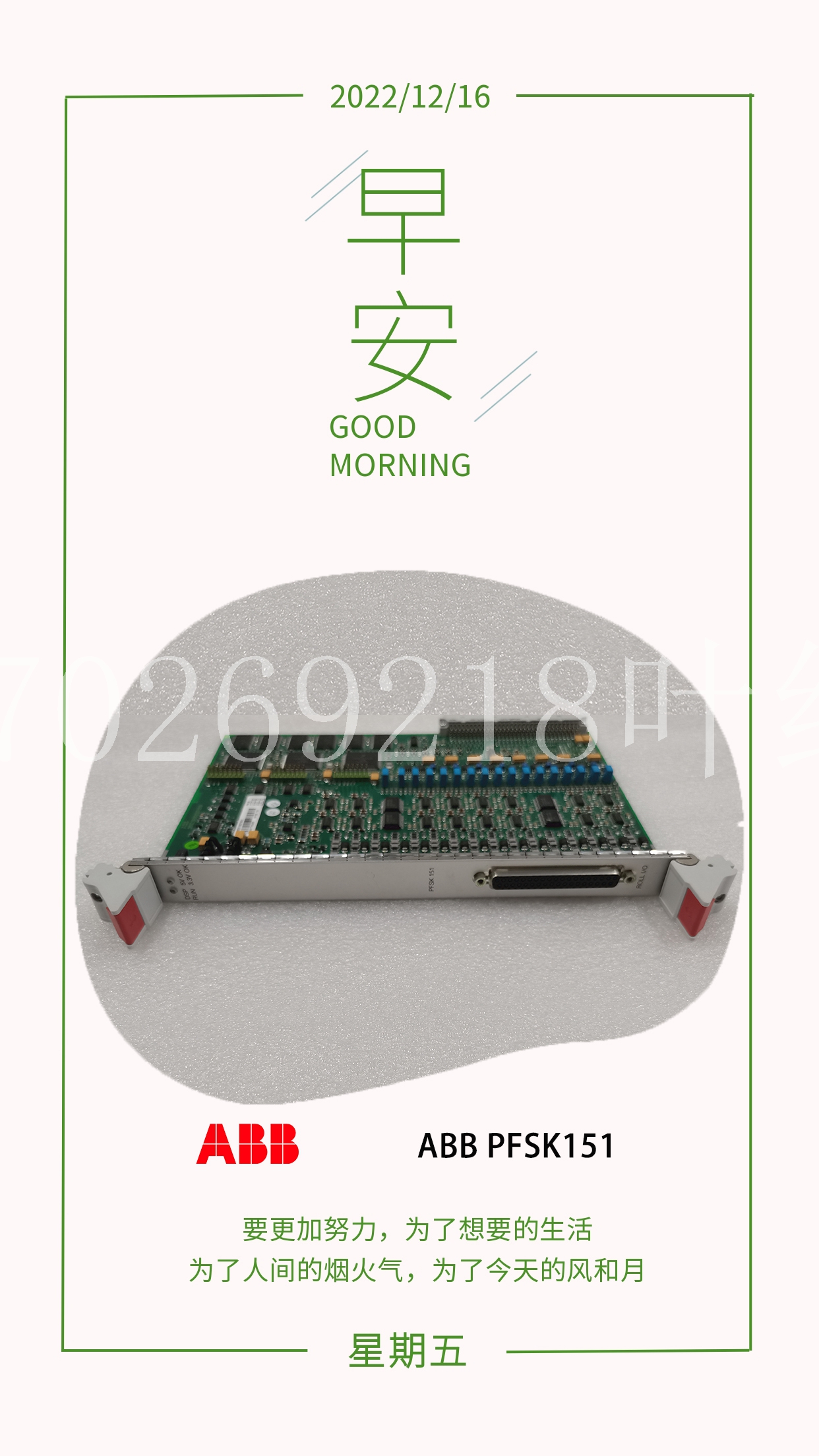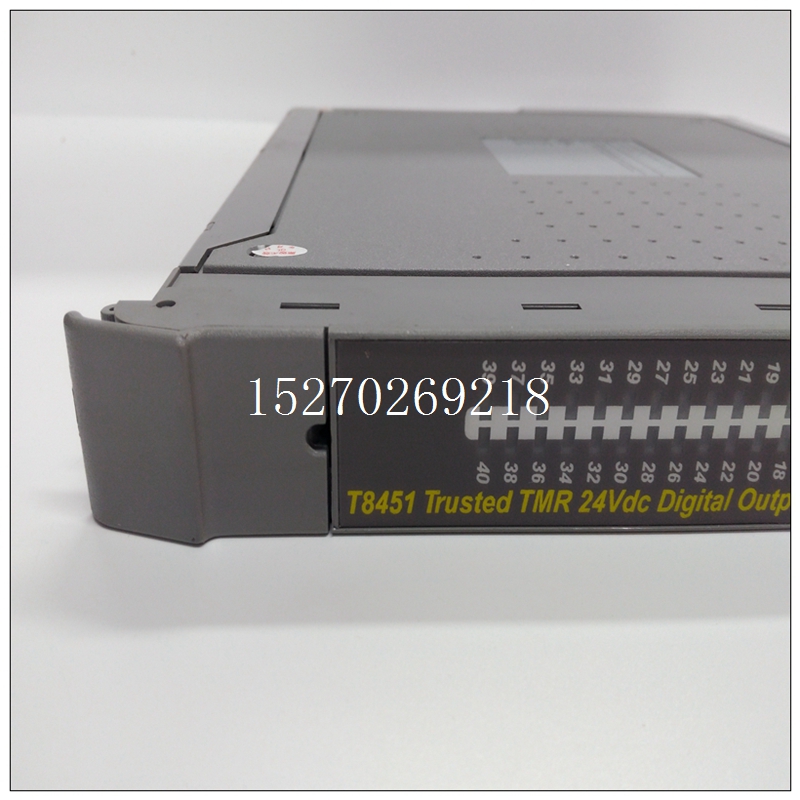ICS TRIPLEX T8912机械设备卡件
❙ ues将代替测量值,可在启动或测试期间使用,以验证输出继电器是否正常工作。只有当电机停止且没有跳闸、报警或启动块激活时,输出继电器才能强制运行。如果任何继电器被强制运行,则继电器将从其正常状态(无跳闸、报警或闭塞)切换至其激活状态。此时,相应的继电器指示灯将点亮。选择“禁用”将使输出继电器重新投入使用。如果469测量相电流或控制功率循环,则继电器的强制操作设定值将自动禁用,输出继电器将恢复到正常状态。如果强制任何继电器,469在用LED将闪烁,表明469未处于保护模式。4.14.5测试模拟输出除模拟模式外,在启动或测试期间,可使用测试模拟输出设定值组来验证模拟输出是否正常工作。只有当电机停止且没有跳闸、报警或启动块激活时,才能强制模拟输出。当FORCE ANALOG OUTPUTS FUNCTION(强制模拟输出功能)为“Enabled”(启用)时,输出将强制值反映为4至20 mA或0至1 mA范围的百分比。选择“Disabled”(禁用)将使所有四个模拟输出通道重新投入使用,反映为每个通道编程的参数。如果469测量相电流或循环控制电源,则FORCE ANALOG OUTPUTS FUNCTION(强制模拟输出功能)将自动禁用,所有模拟输出将恢复到正常状态。每当模拟输出被强制时,469在用LED将闪烁,表明469 S13 469 TESTING 4 4.14.6 COMM PORT MONITOR(通信端口监视器)在对通信问题进行故障排除的过程中,查看从某个主设备首先传输到469的数据,然后查看469传输回该主设备的数据非常有用。此处显示的消息应该可以查看该数据。可以监控三个通信端口中的任何一个。清除通信缓冲区后,从被监控的通信端口接收的任何数据将存储在Rx1和Rx2缓冲区中,“//”用作消息之间的字符分隔符。如果469发送消息,它将出现在Tx1和Tx2缓冲器中。除这些缓冲器外,还有一条消息将指示状态管理继电器GE电源管理4.15 S14双速电机4设定点编程4.15 S15双速电机4.15.1说明双速电机功能为两个不同满载值的双速电机提供适当保护。该算法使用两种速度的常用热容量寄存器值将每种速度下的加热集成到一个热模型中。如果使用双速电机功能,ASSIGNABLE INPUT4专用于双速电机监视器,端子D22和D23用于触点闭合。触点闭合表示电机处于速度2。如果输入打开,则表示电机处于速度1。这允许469确定在任何给定时间点应激活哪些设定点。SPEED2 MIN ALLOWABLE LINE VOLTAGE(速度2最小允许线路电压):80%范围:70至95%;步骤:1仅当选择了电压相关曲线样式时才显示消息SPEED2 ISTALL@MIN Vline:4.80 x FLA范围:2.00至15.00 x FLA;步骤:仅当选择了电压相关曲线样式时才显示0.01消息SPEED2 SAFE STALL@MIN Vline:2.0 s范围:0.5至999.9秒;步骤:仅当选择“电压相关曲线样式”时才显示0.1消息SPEED2 ACL INTERSECT@MIN Vline:3.80 x FLA范围:2.00至Istall@Min_Vlinex FLA;步骤:仅当选择了电压相关曲线样式SPEED2 4.15 S14双速电机4设定点编程4时,才会看到0.01消息。速度1的所有热模型参数设置将与速度2相同。此处可为速度2、高速编程第二过载曲线设置。4.15.3速度2欠电流增加第二个欠电流跳闸或报警级别可能很有用,因为它将指示错误的速度是否使用了错误的设定值,即速度2的正常运行电流可能是欠电流,速度为更多的BLOCK SPEED2 U/C FROM START:0 s Range:0 to 15000 s,步骤1速度2 U/C alarm:Off Range:Off,Latched,未锁定的SPEED2 U/C警报拾取:0.70 x FLA范围:0.10至0.95 x FLA,步骤0.01 SPEED2 U/C警报延迟:1 s范围:1至60秒,步骤1 SPEED2 U-C警报事件:关闭范围:打开,关闭速度2 U/C跳闸:0ff范围:关闭,锁定,未锁定速度2 U/C跳闸传感器:0.70 x FLA范围:0.10 4.15 S14双速电机4 4.15.4速度2加速度双速电机功能提供了两个额外的加速计时器。一个计时器用于从停止状态启动速度2。另一个是用于从速度1转换到速度2的加速计时器。此外,虽然t
❙ ues will be substituted for the measured values may be used during startup or testing to verify that the output relays are functioning correctly. The output relays can only be forced to operate only if the motor is stopped and there are no trips, alarms, or start blocks active. If any relay is forced to operate, the relay will toggle from its normal state when there are no trips, alarms, or blocks to its active state. The appropriate relay indicator will illuminate at that time. Selecting "Disabled" places the output relays back in service. If the 469 measures phase current or control power is cycled, the FORCE OPERATION OF RELAYS setpoint will automatically become disabled and the output relays will revert back to their normal states. If any relay is forced, the 469 In Service LED will flash, indicating that the 469 is not in protection mode. 4.14.5 TEST ANALOG OUTPUT In addition to the simulation modes, the TEST ANALOG OUTPUT setpoint group may be used during startup or testing to verify that the analog outputs are functioning correctly. The analog outputs can only be forced if the motor is stopped and there are no trips, alarms, or start blocks active. When the FORCE ANALOG OUTPUTS FUNCTION is "Enabled", the output reflects the forced value as a percentage of the 4 to 20 mA or 0 to 1 mA range. Selecting "Disabled" places all four analog output channels back in service, reflecting the parameters programmed to each. If the 469 measures phase current or control power is cycled, the FORCE ANALOG OUTPUTS FUNCTION is automatically disabled and all analog outputs revert back to their normal state. Any time the analog outputs are forced, the 469 In Service LED will flash, indicating that the 469 S13 469 TESTING 4 4.14.6 COMM PORT MONITOR During the course of troubleshooting communications problems, it can be very useful to see the data that is first being transmitted to the 469 from some master device, and then see the data that the 469 transmits back to that master device. The messages shown here should make it possible to view that data. Any of the three communications ports may be monitored. After the communication buffers have been cleared, any data received from the communications port being monitored will be stored in the Rx1 and Rx2 buffers with ‘//’ acting as a character break between messages. If the 469 transmits a message, it will appear in the Tx1 and Tx2 buffers. In addition to these buffers, there is a message that will indicate the status Management Relay GE Power Management 4.15 S14 TWO-SPEED MOTOR 4 SETPOINT PROGRAMMING 4 4.15 S14 TWO-SPEED MOTOR 4.15.1 DESCRIPTION The two-speed motor feature provides proper protection for a two-speed motor where there will be two different full load values. The algorithm integrates the heating at each speed into one thermal model using a common thermal capacity used register value for both speeds. If the two-speed motor feature is used, ASSIGNABLE INPUT4 is dedicated as the two-speed motor monitor and terminals D22 and D23 are monitored for a contact closure. Closure of the contact signifies that the motor is in Speed 2. If the input is open, it signifies that the motor is in Speed 1. This allows the 469 to determine which setpoints should be active at any given point in time. SPEED2 MIN ALLOWABLE LINE VOLTAGE: 80% Range: 70 to 95%; Step: 1 Message seen only if Voltage Dependent Curve Style is selected SPEED2 ISTALL @ MIN Vline: 4.80 x FLA Range: 2.00 to 15.00 x FLA; Step: 0.01 Message seen only if Voltage Dependent Curve Style is selected SPEED2 SAFE STALL @ MIN Vline: 20.0 s Range: 0.5 to 999.9 sec; Step: 0.1 Message seen only if Voltage Dependent Curve Style is selected SPEED2 ACL INTERSECT @ MIN Vline: 3.80 x FLA Range: 2.00 to Istall@Min_Vline x FLA; Step: 0.01 Message seen only if Voltage Dependent Curve Style is selected SPEED2 4.15 S14 TWO-SPEED MOTOR 4 SETPOINT PROGRAMMING 4 All the Thermal Model parameters set for Speed 1 will be identical for Speed 2. A second overload curve setup may be programmed here for Speed 2, High Speed. 4.15.3 SPEED2 UNDERCURRENT The addition of a second Undercurrent trip or alarm level may be useful as it will indicate if the wrong setpoints are being used for the wrong speed i.e. normal running current for Speed 2 may be undercurrent for Speed for more BLOCK SPEED2 U/C FROM START: 0 s Range: 0 to 15000 s, step 1 SPEED2 U/C ALARM: Off Range: Off, Latched, Unlatched SPEED2 U/C ALARM PICKUP: 0.70 x FLA Range: 0.10 to 0.95 x FLA, step 0.01 SPEED2 U/C ALARM DELAY: 1 s Range: 1 to 60 sec., step 1 SPEED2 U/C ALARM EVENTS: Off Range: On, Off SPEED2 U/C TRIP: 0ff Range: Off, Latched, Unlatched SPEED2 U/C TRIP PICKUP: 0.70 x FLA Range: 0.10 4.15 S14 TWO-SPEED MOTOR 4 4.15.4 SPEED2 ACCELERATION Two additional acceleration timers are provided for the two speed motor feature. One timer is for a start in Speed 2 from a stopped condition. The other is an acceleration timer for the transition from Speed 1 to Speed 2. Also, while the motor is running, the 469 will ignore Mechanical Jam protection during the acceleration from Speed 1 to Speed 2 until the motor current has dropped below Speed 2 FLA × Overload Pickup value, or the Speed 1-2 acceleration time has expired. At that point in time, the Mechanical Jam feature will be enabled with the Speed 2 FLA ❙ s Range: 1.0 to 250.0 sec., step: 0.1 Seen only if one of the digital inputs is assigned as Speed Switch SPEED2 RATED SPEED: 3600 RPM Range: 100 to 7200 RPM; Step: 1 Seen only if one of the digital inputs is assigned as Measured values, maintenance and fault analysis information are accessed in Actual Value mode. Actual values may be accessed via one of the following methods: 1. The front panel, using the keys and display.












